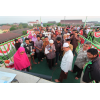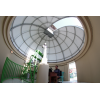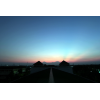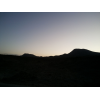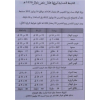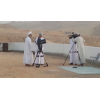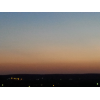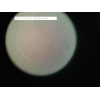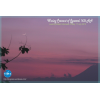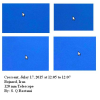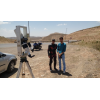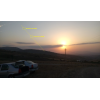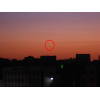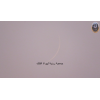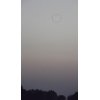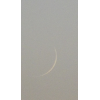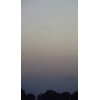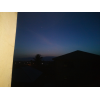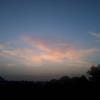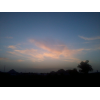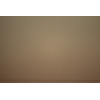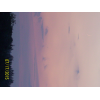Visibility of Shawwal Crescent 1436 AH
- When to Observe Shawwal Waxing (NEW) Crescent ?
- Shawwal Waxing (NEW) Crescent Observation Results
- The OFFICIAL First Day in Different Countries
- When to Observe Ramadan Waning (OLD) Crescent ?
- Ramadan Waning (OLD) Crescent Observation Results
When to Observe Shawwal Waxing (NEW) Crescent ?
The geocentric conjunction (Geocentric New Moon) will occur Inshalla on (Thursday 16 July 2015) at 01:24 UT.
Sighting the new crescent on (Thursday 16 July 2015) and (Friday 17 July 2015) is shown in the below graphs using the program Accurate Times by Mohammad Odeh according to Odeh criterion. Where:-
- It is impossible to see the crescent from the areas located under the red color. Because either the Moon on this day sets before the Sunset and/or the topocentric conjunction occurs after the Sunset.
- The crescent is expected to be seen by optical aid only from the areas located under the blue color.
- The crescent is expected to be seen by optical aid from the areas located under the magenta color. In these areas the crescent could be seen by naked eye if the atmospheric conditions are superb and the observer is experienced.
- The crescent is expected to be easily visible by naked eye from the areas located under the green color.
- The crescent cannot be seen from uncolored areas, even though the Moon sets in these locations after the Sunset and the topocentric conjunction occurs before the Sunset, but the Moon is not sufficiently illuminated in order to be seen as crescent even by optical aid.
- Kindly notice that the below graph shows the possibility of seeing the crescent from areas between 60 degrees north of Equator down to 60 degrees south of Equator.
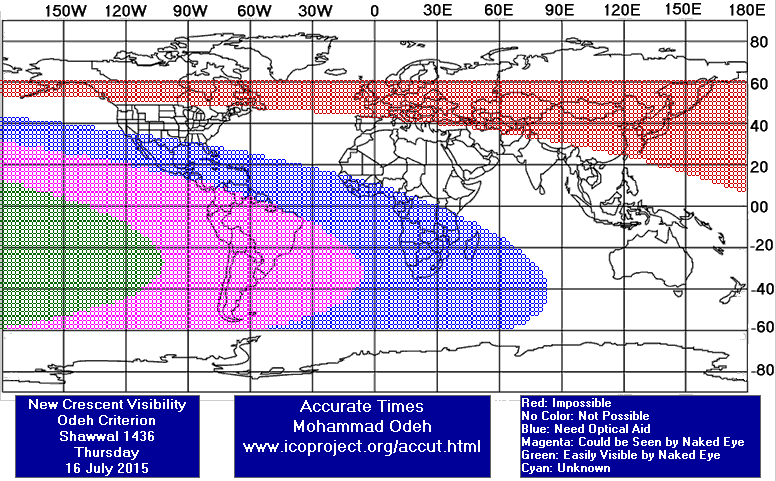
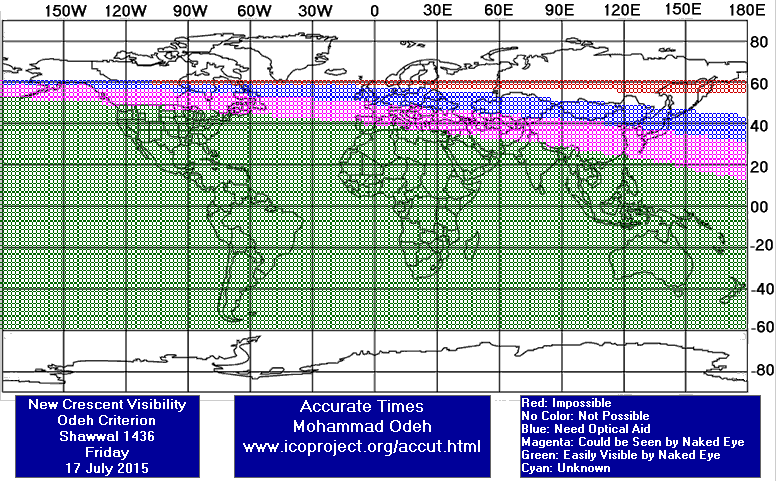
According to the Universal Hejric Calendar (UHC), which is based on the calculated crescent visibility, the start of this month in the Eastern Region will be on Friday 17 July 2015 and in the Western Region will be on Friday 17 July 2015. Kindly notice that the UHC is a pre-calculated calendar, which adopts a certain criterion to start the new Hejric month. Your country/organization might adopt different criterion to start the new Hejric month. So it is highly advised to read the UHC website before giving any judgment.
- Results of seeing the crescent, and the first day of the month in different countries will be added here Inshalla as we receive the reports from ICOP's members. If you wish to be a member in ICOP, or to know more about it, kindly click here.
Shawwal Waxing (NEW) Crescent Observation Results
Thu 16 July 2015
Algeria
Australia
Brunei Darussalam
Mr. Hazarry Haji Ali Ahmad said: "With the consent of His Majesty the Sultan and Yang Di-Pertuan of Brunei Darussalam, President of the Brunei Islamic Religious Council (MUIB) said the moon sighting was be carried out simultaneously at several locations (DST tower, Agok Hill & Lumut hill) across the country failed to sight the new crescent. The official announcement was reported by state broadcaster Radio Televisyen Brunei (RTB)that Brunei will observe the Eid Fitri on Saturday, July 18. "
Germany
Eng. Martin Elsaesser said: "As the moon would set before the sun in the evening from my location i had to try daytime observation. Conditions were good with blue enough skies and no clouds but some haze. I setup the instrument 2 hours before noon, when the moon was already 45° high, trailing the sun at an elongation of 6.6°, less than 8 hours after conjunction. I could image the moon clear enough with the established imaging technique. I will later try to measure contrast levels in the raw-data and extend the report. I tried to see the crescent visually with the same telescope but could not see it, as expected. "
Mr. Usman Dukku said: "Because the moon set before sunset, here in Oberursel, Near Frankfurt, Germany, I did not attempt sighting the crescent."
Ghana
Mr. Baba Abdulai said: "Date of sighting effort; Thursday July 16, 2015. The crescent was NOT seen in this location. I was at the sighting post from about 18:23 to about 19:05 but I did not see the crescent. The sky was largely cloudy, per my observation. Moon age was about 17 hours after conjunction as at sunset local time in Tamale; with a moon lag time of about 23 minutes. Considering that the moon lag time is only 23 minutes, I did not expect to see the crescent today. I have however received reliable information that the Office of the National Chief Imam in Ghana has announced that Saturday July 18, 2015 will be Eidul Fitr. And Allaah (SWT) Knows Best. Sighting community; Tampei-Kukuo Yepalsi, (near Bi-Water reservoir), Tamale."
Indonesia
Mr. AR Sugeng Riyadi said: "The crescent observation of Shawal 1436 H (July 16th, 2015) had been succesfully held at Assalaam Observatory, The Modern Boarding School of Islam ASSALAAM, Pabelan Kartasura Sukoharjo Central Java Indonesia. The sky was averagely cloudy from the morning until nearly afternoon. On the afternoon the sky was little bit hazy on the horizon. The observation started about 03.00 pm until sunset. Till the end of observation, the crescent was not succesfully captured by the observers. This event was opened for public. About hundreds people and delegations of the ministry of religious affair also attend on this event. The vice director of Assalaam boarding school also attended the observation. Finally the observation finished on 06.00 pm after maghrib. "
Iran
Jordan
Kuwait
Morocco
Nigeria
Dr. Usman El-Nafaty said: "Report of negative sighting was sent earlier. The official date for 1st day of Shawwal 1436 is Friday 17th July 2015. Eid Mubarak to all."
Mr. Yunusa Yakubu said: "There was poor visibility due to cloud in fact, the sun was out of sight thirty minutes before its setting time. "
Oman
Eng. Mundhir AlShibani said: "The Crescent was not seen. We started observing before sunset and after Sunset.The atmospheric condition was hazy and dusty at the west horizon. More about todays crescent data : http://astroceanomy.com/2015/06/12/crescent-visibility-combined-report-for-ramadan-shawwal-1436/"
Prof. Mohammed Al-Bussaidi said: "The crescent Moon was not sighted from Muscat area. The weather was hot, less humid, hazy, dusty and cirrus clouds on the western horizon."
Philippines
Mr. Abu Ammar Mangorangca said: "A party of Muslims in Binalbagan City, Negros Island, central Philippines, tried to observe the moon after sunset Thursday, headed by Abu Sohaili Laguindab, who frequently undertake hilal watching in other places in the Philippines. Despite the presence of fair weather and a commanding view of the western horizon across the sea, the group did not see any moon."
Saudi Arabia
South Africa
Dr. Abdurrazak Ebrahim said: "Negative sighting reports from all African countries south of the equator"
Tunisia
United States
Dr. Javad Torabinejad said: "I arrived at my sighting location (Blacksburg Middle School) at 8:34 pm EDT (sunset: 8:41 pm). The western horizon was mostly cloudy and hazy. Although I did not expect to sight the moon even by using a telescope under perfect conditions, I searched for the crescent in the clear patches with naked eye and a pair of binoculars (7X50). With no success, I ended the session after moonset (moonset: 8:56 pm)."
Mr. Milad Ali Ershaghi said: "as Salamu alaykum wa rahmatulLah On Thursday, July 16th, 2015, sunset was about 8:04pm and moonset at about 8:27pm at Palos Verdes Estates, California, USA - a city located on the West Coast of Southern California. I looked for the crescent moon between these times from a point overlooking the ocean where atmospheric conditions were clear but was unable to see it. Milad Ali Ershaghi Palos Verdes Estates, California, USA"
Fri 17 July 2015
Algeria
Mr. Abd Elouahed Delih said: "السلام عليكم ورحمة الله وبركاته تم بحمد الله مشاهدة هلال شوال 1436 هـ يوم 17 جويلية بعد غروب الشمس وكان نحيلا وقد سجلت الرصد بفيديو من جزئين وهذان رابطاهما. https://www.youtube.com/watch?v=ZnPwkN76zpg https://www.youtube.com/watch?v=d0J2pV4-kZ0"
Bahrain
Bangladesh
Egypt
Mr. AbdelHamid Ahmed said: "ولله الحمد تمت رؤية الهلال بالعين المجردة بعد الغروب ب4 دقائق الصورة معكوسة بسبب التلسكوب ولمعلومات اكثر يرجى الدخول على الصفحة https://www.facebook.com/eptmtc?ref=tn_tnmn "
Ghana
Mr. Baba Abdulai said: "Date of sighting effort; Friday July 17, 2015. The crescent was SEEN in this location. I first saw the crescent at about 18:50 local time, immediately after Magrib Prayer. Crescent horns orientation was about 3 to 7 o’clock. The sky was clear, per my observation. Moon age was about 41 hours after conjunction as at sunset local time in Tamale; with a moon lag time of about 1 hour and 9 minutes. I already expected to see a big crescent quite easily, and rightly so. And Allaah (SWT) Knows Best. Sighting community; Sagnerigu, Tamale."
Mr. Abdul-Aziz Anyang said: "The new crescent was clearly seen by a lot people in the Upper East region of Ghana. In the Greater Accra region of Ghana, just before sunset at our local time, the western end of the sky became cloudy, hence the hilal was not seen. Eid Mubarak."
Hungary
Indonesia
Mr. AR Sugeng Riyadi said: "The daytime crescent of shawwal 1436 AH was seen from Assalaam Observatory, Pabelan Kartasura Sukoharjo Central Java Indonesia on Friday 17 July 2015 at 08:50 LT. Observation and Image Processing by mr. Muflih Arisa Adnan. CCD Skyris 445M, William Optics 71mm and Spinx Eq Mount."
Mr. AR Sugeng Riyadi said: "I tried to observe the new crescent of Syawwal 1436 AH with my family from my personal observatory at Bendo Ketitang Juwiring Klaten Central Java Indonesia on Friday, July 17, 2015. The new Crescent of Syawwal 1436 AH was SEEN after sunset by me and all my family. Eid Mubarak for all my brothers :-)"
Mr. Muhamad Reyhan Respati said: "I've seen the crescent from a field near my house. However, it's officially announced in Indonesia that 1 Syawal 1436 is 17 July 2015"
Iran
Eng. Seyyed Ghasem Rostami said: "The crescent has seen by 120 mm telescope in 11:35 to 120:30."
Eng. Seyyed Ghasem Rostami said: "The crescent has seen by telescope in 19:35 (before sunset) and it has seen by naked eyes in 20:00."
Mr. Hossein Janghorbani said: "In the name of God Shawwal Crescent Observation Report Astronomy and Geophysics Center of Shahreza – The Crescent Association of Shahreza- Accompanied by Astronomy Center of Khomeynishahr Isfahan Report by: Hossein Janghorbani (Najmosepehr-Sadrolmonajemin) – Manager of Shahreza Crescent Association and Red Crescent’s Astronomy and Geophysics Center Date: Friday, 07/17/2015 Location: Damzad foothills in the East of Shahreza (latitude: 32 00 N, longitude: 51 52 E, elevation: 1825m from sea level, time zone: +4.5 GMT) Equipments: two sets of 25*100 binoculars, two sets of 15*70 binoculars , six sets of 20*90 binoculars, one sets of 20*80 binoculars,one telescope 10 inch, one compass. Atmospheric condition: Very hazy in western horizon. Horizon obstacles: 2° Apparent sunset: 19:59 Apparent Moonset: 20:39 Results: Moon crescent was seen by 20*90 binoculars by Mahsa Khajeh and Reza Janghorbani at 20:8 between dust and hazy, for the first time. Other group members observed crescent by binoculars and telescope subsequently. At the end , Festival Fourth spring Ramadan was held Observers: 1.Hosein Janghorbani 2.Ali Janghorbani 3.Reza Janghorbani 4.Farzad Alavi 5.Shahriyar Gholami 6.Abdorreza Gholami 7.Mohsen Tavoosi 8.Mehdi Fakhri 9.Mohammad javad Talebpur 10.Sina Tavoosi 11.Ali reza Esmaeli 12.Ahmad Rahmat 13.Ali Rahmati 14.Hamid reza Elahi nezhad 15.Nasrolah Elahi nezhad 16.Mohammad ali Afshin 17.Zahra Falahi 18.Fateme Hadad 19.Ziba Hafar 20.Masome Hafar 21.Mahsa Khaje 22.Reihaneh Dadvand 23.Zahra Malekian 24.Roghaye Karimi 25.Ensie Javeri 26.Zohre Karimpor 27.Maryam Bagherpor 28.Fateme Zahra Talebpor 29.Talat Khodadadpor 30.Soheila Elahi nezhad 31.Zahra Farokhpor 32.Fahime Nili 33.Shakiba Safar 34.Zahra Eslamipor 39.Najme Bagheri 40.Shaghayegh Sarami 41.Zahra Tavakoli 42.Samira Emadi 43.Leila Fakhari 44.Zeinab Peimani 45.Zahra Aghaei 46.Fateme Mohamadi 47.Atefe Khakdan 48.Yasaman Keivani 49.Fateme Dadvar 5 50.Fahime Ebrahim babaei 51.Fateme Haji heidari 52.Fateme Karimi 53. Poya Karimi 54. Amir Masood Dehghani 55.Mehdi Aflaki 56.Mohamad bagher Taheri 57.Mohamad javad Kazemi 58.Kamal Kazemi 59.Ali Rezaei 60.Arash Karbalaei 61.Abas Karbalaei 62.Mohamad Javad Shokrani 63.Milad Baghlavaei 64.Mehdi Bagheri 65.Amir hosein Hajian 66.Reza Parande 67.Abolfazl Shiravi 68.Ali Saffari 69.Amir hosein Aghaei 70.Ali Bani hashemi 71.Kamran Shir bache 72.Ali Shir bache 73.Hamze Sarami 74.Seyed Jafar Mosavi 75.Abas ali Mandegar 76.Saeed Momayez 77.Seyed Abolfazl Kahangi 78.Mojtaba Same 79.Seyed Alireza Hejazi 80.Seyed Mohammad mehdi Hejazi 81.Seyed Mohamad hadi Hejazi 82.Mohamad Mehdi Gharavi 83.Hosein Gharavi 84.Mohamad reza Gharavi 85.Amir hosei Gharavi 86.Sheykh Ali Gharavi 87.Rohol amin Saeedi 88.Fateme Gharavi 89.Atefe Gharavi 90.Mahbobe sadat Bakhtiyari 91.Hasan Sanaee "
Jordan
Dr. Ayman Al-Layla said: "كانت رؤية الهلال ليست بالسهلة وتحتاج لتركيز شديد وكأنني أرى خيط عنكبوت في الأفق ... وبالكاد استطعت أن أصوره باستخدام كاميرا كانون العادية 14 ميغابكسل ... لا أعلم حقيقة كيف ادعى الشهود رؤيته بالعين المجردة البارحة من المنطقة العربية !!!"
Libya
Eng. Mohammed Abdulkarim said: "كانت الرؤية مساء اليوم في غاية الصعوبة وذلك بسبب إرتفاع نسبة الرطوبة في الجو ووجود بعض السحب... وكل عام وأنتم بخير"
Morocco
Eng. Abdelhafid Bani said: "يظهر في الصورة على نفس ارتفاع المدخنة و فوق الهوائي على شكل T"
Nigeria
Mr. Qamarudeen Muhammad said: "It was seen easily"
Dr. Sani Mustapha said: "At 19.10 the was a bright star to the left of the sun set. The crescent was then see low down under thin clouds. Once the atmospheric condition is good for visibility the visibility curve of Odeh is a guide to sighting the moon. Id the atmospheric condition is not conducive to sighting the crescent, then the visibility curve is enough. "
Mr. Yunusa Yakubu said: "Eidul-Fitr was observed in Nigeria Today Friday 17/07/2015 based on CLAIMED SIGHTING. Its surprising that such Crescent was not easily sighted at sunset and has practically lasted for 22 mins. This year the major predicaments for Muslim World is the Saudi Claimed Sighting.and as we can see in moonsighting.com, over 40 Countries followed Saudi."
Saudi Arabia
Mr. Saleh Al-Saab said: "كان الغبار شديدا لدرجة أن الشمس إختفت قبل وقت غروبها بأكثر من عشر دقائق."
Sri Lanka
Mr. Nular Bary said: " Assalamualaikum W R W B Today 29th.of Ramadan (17/07/2015) evening the Colombo sky was covered with heavy clouds.The new Moon of Shawwal was sighted in Kennya N.E. city of Sri Lanka and Puttalum N.W. city of Sri Lanka. Hence The Colombo Grand Mosque Hillal Committee decided to start the 1st. of Shawwal and celebrate the Eid ul Fithur tomorrow Saturday 18th July 2015 "In Sha Allah""
Mr. Abdul Rahman Razeen said: "A.alaikum. Today it was 29th evening of Ramadan. Plenty of arrangements was made right across the country to sight the crescent. Though the parameters show it was sightable easily the atmospheric conditions was not at it's best. It was a breezy day. So i was in alert to guide the sighters through the phone. Alhamdulillah! It was sighted in the N.eastern province in Kinniya, kandalai,and Mudur by our C.G.M. Co-ordinators just after 20mnts of S.set. The orientation was 3o'clock-7o'clock. It was decided by the authorities of C.G.M. to celebrate eid on Saturday. So eid mubarak"
Tunisia
United States
Dr. Javad Torabinejad said: "I arrived at my sighting location (The Blacksburg Middle School) at 8:38 pm EDT (sunset: 8:40 pm). Using a pair of binoculars (7X50), I scanned the partly cloudy western horizon. My first binocular sighting was at 8:45 pm. The crescent elevation was about 8 degrees. Soon after, the crescent was seen with naked eye. The horns were at 2:00 and 6:00 O'clock (2:00;4:00;6:00). I left the area at 9:20 pm when moon disappeared behind clouds about 2 degrees above the horizon (moonset: 9:34 pm)."
The OFFICIAL First Day in Different Countries
Fri 17 July 2015
1 . Algeria
2 . Australia
3 . Bahrain
4 . Egypt
5 . Indonesia
6 . Iraq
7 . Jordan
8 . Kuwait
9 . Lebanon
10 . Libya
11 . Malaysia
12 . Nigeria
13 . Palestine
14 . Qatar
15 . Saudi Arabia
16 . Sudan
17 . Syria
18 . Tunisia
19 . Turkey
20 . United Arab Emirates
Sat 18 July 2015
1 . Bangladesh
2 . Brunei Darussalam
3 . Ghana
4 . Iran
5 . Morocco
6 . Oman
7 . South Africa
8 . Sri Lanka
When to Observe Ramadan Waning (OLD) Crescent ?
The geocentric conjunction (Geocentric New Moon) will occur Inshalla on (Thursday 16 July 2015) at 01:24 UT.
Sighting the OLD crescent on (Thursday 16 July 2015) and (Wedensday 15 July 2015) is shown in the below graphs using the program Accurate Times by Mohammad Odeh according to Odeh criterion. Where:-
- It is impossible to see the OLD crescent from the areas located under the red color. Because either the Moon on this day rises after the Sunrise and/or the topocentric conjunction occurs before the Sunrise.
- The crescent is expected to be seen by optical aid only from the areas located under the blue color.
- The crescent is expected to be seen by optical aid from the areas located under the magenta color. In these areas the crescent could be seen by naked eye if the atmospheric conditions are superb and the observer is experienced.
- The crescent is expected to be easily visible by naked eye from the areas located under the green color.
- The crescent cannot be seen from uncolored areas, even though the Moon rises in these locations before the Sunrise and the topocentric conjunction occurs after the Sunrise, but the Moon is not sufficiently illuminated in order to be seen as crescent even by optical aid.
- Kindly notice that the below graph shows the possibility of seeing the crescent from areas between 60 degrees north of Equator down to 60 degrees south of Equator.


Ramadan Waning (OLD) Crescent Observation Results
Wed 15 July 2015
Germany
Eng. Martin Elsaesser said: "There were clouds before sunrise (yesterday also), so i had to try daytime observation. The weather conditions were ok with blueish skies and some white clouds, not too hot. The crescent could be easily imaged in the early afternoon some 9° from the sun and high in the sky. Sadly, the crescent will set before the sun tomorrow, so i will again have to try daytime observation."
Indonesia
Mr. AR Sugeng Riyadi said: "The old Crescent of Ramadhan 1436 AH was SEEN from Assalaam Observatory, The Modern Boarding School of Islam ASSALAAM Pabelan Kartasura Sukoharjo-Surakarta Central Java Indonesia. I had the observation on Wednesday, July 15th, 2015 with Ustadz Devi Hidayah Fajar, Ustadz Muflih Arisa Adnan and Ustadzah Sirikit Eko Usdiani. More about our activities : https://blogcasa.wordpress.com/2015/07/15/rukyat-hilal-tua-ramadhan-1436-h/"
Mr. AR Sugeng Riyadi said: "This crescent was successufully captured after sunrise by using William Optics ZS71 telescope with the detector of Skyris 445M. We only need less than ten minutes for starting up the telescope, pointing to the sun for alignment, pointing to the moon, capturing the image and finally processing the raw image. for further story please visit our link bellow https://blogcasa.wordpress.com/2015/07/15/rukyat-hilal-tua-ramadhan-1436-h/"
Iran
Eng. Seyyed Ghasem Rostami said: "The mercury rise at 4:52 from a mountain that its altitude was 1.1 degrees. I saw the crescent hardly at 5:24 to 5:27 by 120 mm telescope."




